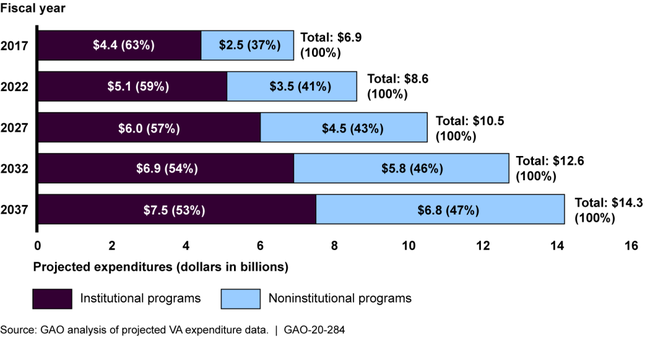VA Health Care: VA Faces Challenges in Meeting Demand for Long-Term Care
Fast Facts
Veterans rely on long-term care from the VA for everything from occasional help around the house to round-the-clock care. Eligibility is mostly based on the extent of a service-connected disability.
We testified that demand for long-term care increased 14% and VA’s spending went up 33% from FY 2014-2018. VA projects that demand will continue to increase and spending will double by 2037.
VA faces 3 key challenges to meeting long-term care needs: finding enough workers, providing care where geographically needed, and providing specialty care.
We previously made 3 recommendations, including that VA develop measurable goals in these areas.

The United States Capitol
Highlights
What GAO Found
The Department of Veterans Affairs (VA) provides or purchases long-term care for eligible veterans through 14 long-term care programs in institutional settings like nursing homes and noninstitutional settings like veterans' homes. From fiscal years 2014 through 2018, VA data show that the number of veterans receiving long-term care in these programs increased 14 percent (from 464,071 to 530,327 veterans), and obligations for the programs increased 33 percent (from $6.8 to $9.1 billion). VA projects demand for long-term care will continue to increase, driven in part by growing numbers of aging veterans and veterans with service-connected disabilities. Expenditures for long-term care are projected to double by 2037, as shown below. According to VA officials, VA plans to expand veterans' access to noninstitutional programs, when appropriate, to prevent or delay nursing home care and to reduce costs.
VA Projections for Long-Term Care Expenditures, Fiscal Years 2017 through 2037

Note: These long-term care programs include those VA projects using its Enrollee Health Care Projection Model. This model includes 12 of VA’s 14 Long-Term Services and Supports programs, excluding State Veterans Homes and State Home Adult Day Health Care.
VA currently faces three key challenges meeting the growing demand for long-term care: workforce shortages, geographic alignment of care (particularly for veterans in rural areas), and difficulty meeting veterans' needs for specialty care. VA's Geriatrics and Extended Care office (GEC) recognizes these challenges and has developed some plans to address them. However, GEC has not established measurable goals for these efforts, such as specific staffing targets for programs with waitlists or specific targets for providing telehealth to veterans in rural areas. Without measurable goals, VA is limited in its ability to address the challenges it faces meeting veterans' long-term care needs.
For more information, contact A. Nicole Clowers at (202) 512-7114 or clowersa@gao.gov or Sharon Silas, Director, Health Care, at (202) 512-7114 or silass@gao.gov.
